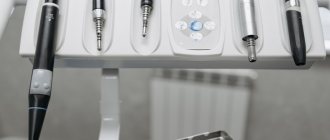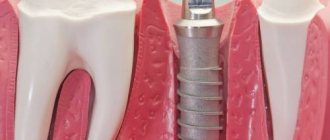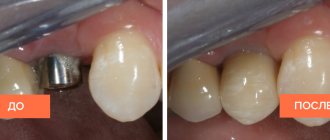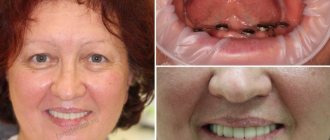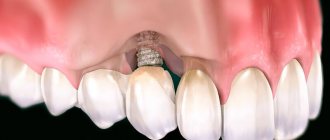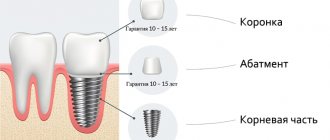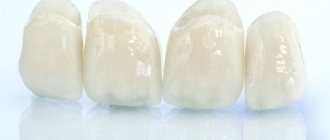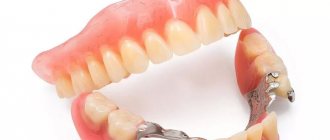Surgery to increase breast size or change its shape and volume is one of the most popular in plastic surgery. However, the intervention must be carried out by an experienced surgeon who, together with the patient, will select the most optimal size and shape, as well as the type of breast implants.
But many patients, deciding on surgical intervention, do not know that breast plastic surgery with the placement of implants is carried out for a certain period of time, since over time there may be a need for repeated intervention, including replacement of implants.
Features of implantation
Dental prosthetics on implants, thanks to high-quality fixation, increases the functional properties of the prosthesis and also increases its service life.
But a lot also depends on the service life of the dental implants themselves. This period can range from 5 or even 30 years, but structural manufacturers often claim a lifetime warranty. When the next implantation will be necessary depends on many factors. Some models themselves have a certain period of functionality, others are highly dependent on operating conditions. Pathologies of the oral cavity or neighboring teeth also have an impact.
In order to be confident in the quality of implantation and the long service life of the implant, you should pay special attention to the choice of a specialist, the model of the product and compliance with all the doctor’s recommendations for the preparation and operation of the product.
Recovery after implant replacement surgery
First week
- During the first week, the patient will need to sleep with his head and back elevated to reduce swelling in the chest area. You can use wedge-shaped pillows, or sleep in a chair-bed.
- The plastic surgeon will probably allow showering one to three days after surgery, but will strictly prohibit bathing, spa treatments, or hot tubs for at least four weeks after surgery.
- Depending on the doctor's recommendations, the dressings will be removed within a few days after the operation.
- The patient will need to wear a compression bra during the early healing period to prevent fluid accumulation.
- If non-absorbable sutures were placed, they will be removed after about a week.
Two to six weeks
- Minor swelling and swelling should disappear within one month.
- You can return to work within seven to ten days, depending on the type of work you do. In some cases, this period may extend significantly.
- If a patient chooses to have larger implants than they had before surgery, the breast skin may feel slightly tight as the body needs time to adjust to the new size of the implants.
Sensations such as tingling and numbness around the incision may remain for quite a long time, but this is only a temporary phenomenon.
In general, it may take several weeks or months for the implants to “settle” into their final correct position. You can learn more about this operation from the “Breast Augmentation” section.
Types of implants
Modern dental clinics have a huge selection of implants based on material, shape and other criteria.
Products made from titanium alloy are considered the safest and most reliable; they can last more than 30 years. Metal-ceramic structures require replacement after 10–12 years, ceramic ones after 7 years, and metal-plastic ones after 3 years. Implants made of zirconium and aluminum are also durable, their service life is from 1 year. There is a significant difference in price. The latest generation designs are much more expensive, but they have a longer service life, high survival rates, minimal risk of complications and are more comfortable.
The type of product also influences the shelf life of the implant. There are two of them: non-separable and collapsible. Non-removable implants require replacement if the crown is damaged, while dismountable implants can only be partially replaced. For this reason, the non-removable structure can be replaced after 3 years and after 5 years. Removable implants last an average of 12 years.
The lifespan of an artificial root is affected by its design, which is developed taking into account the installation method. Plate-type implants that are implanted into the jaw bone are considered reliable. Root products tend to become loose and may require premature replacement.
In what cases should an implant be replaced?
The decision about the need to replace the titanium rod is made only by the doctor. If you notice any signs of a pathological situation, you must contact the clinic where the implant was installed as soon as possible. These signs include:
- implant mobility;
- pain at the site of its installation, inflammation, redness, swelling;
- implant loss.
It is also worth immediately undergoing an examination if there has been a maxillofacial injury.
Factors that reduce the service life of dental implants
Before implantation is carried out, you will need to decide on the implant model. In order to choose the right product that will last for many years, you should know what criteria you need to pay attention to.
Implant criteria affecting shelf life:
- material - the resistance of the crown to loads will depend on it;
- quality of workmanship and assembly;
- installation method.
Many patients focus solely on the cost of the product, but even the most expensive implants will not last long if they are not initially designed to withstand heavy loads. For example, the installation of non-metallic products on molars is not recommended.
Operating conditions also influence service life. If a patient neglects regular visits to the dentist for the prevention or treatment of dental diseases, eats non-recommended hard foods, or violates other recommendations of the dentist, then the implant may need to be replaced much earlier than the warranty period has expired.
What should you consider before surgery?
During the initial consultation, the first thing the surgeon will inquire about is the patient's specific motivations and will need to assess whether he is a good candidate for implant replacement or full implant revision.
The plastic surgeon will carefully examine, measure and photograph the breasts for medical history and will also need to be aware of the following points:
- Current breast size and shape;
- What type of implant is currently installed;
- What breast size and shape does the patient want to have;
- In what condition and, importantly, quantity are the breast tissue;
- What is the quality of the patient's skin;
- Is the patient satisfied with the placement of the nipples and areolas?
- If there is breast ptosis (sagging), the doctor may recommend a breast lift in combination with implant replacement.
During the consultation, the patient will need to prepare the following information:
- Information about the previous operation;
- Presence of allergic reactions;
- Is the patient undergoing treatment for any disease;
- Have you had any other breast surgery, including breast biopsy?
- What is your family history of breast cancer;
- Current mammogram results;
- If the patient plans to lose a significant amount of weight, the plastic surgeon must be informed about this. He may recommend stabilizing your weight before surgery.
Guarantees for implants
The warranty period that the dental clinic provides to the patient for implants and the work of a specialist does not correspond to the service life declared by the manufacturer.
This is explained by the fact that the manufacturer provides a guarantee for the product, subject to perfect compliance with all operating rules. In fact, this is almost impossible, so dentists give a real guarantee on the product, but also take into account the operating conditions of the implant.
There are three categories of implants based on pricing policies. Budget models usually have a service life of about 5 years. Mid-priced - up to 10 years. If premium class implants are installed, the warranty increases to 20 years. But with all this, dental clinics provide a guarantee of up to 3 years.
Do I need to change breast implants over time if I have ptosis?
Implantation is a way to restore seductive shapes, add volume, and possibly combine it with a lift. You should understand: gravity still acts on tissue, and natural aging processes continue in the body. An artificial bust, like a natural one, drops by 5 cm in 5 years, for each woman the process occurs at an individual speed, depending on muscle training, skin tone and density, volume, genetics, etc.
After a certain number of years, the patient may decide to undergo a breast lift, giving her a youthful appearance. The operation is not mandatory, it is performed for aesthetic purposes at will, in this case the implant can be replaced.
Still have questions? You can ask them at the initial consultation. Sign up via online chat on the website.
Risks of rejection
No implant dentist can give the patient a 100% guarantee that after a while the implant will not be rejected and will not have to be replaced, or even abandon this method of prosthetics.
Rejection of an artificial root occurs due to:
- existing diseases in the patient, which are a contraindication to the procedure, but such a point should be provided for at the preparation stage;
- if the body reacts individually to a foreign body, in this case it is impossible to predict the result of implantation;
- if recommendations are not followed throughout the entire period of operation.
The dental guarantee includes replacement of the implant in the event that rejection occurred due to medical error or the product’s failure to meet the declared quality.
Do I need to change breast implants if complications arise?
Replacement is required in two cases.
The implant burst . Modern products from world leaders have a dense shell and a bonding silicone layer. Rupture can occur due to acute injuries, car accidents, serious bruises, falls, or during related surgical interventions. Silicone gel does not leak outside the capsule. Often, ruptures of silicone implants remain unrecognized for several years. Leaking saline implants are immediately noticeable as ripples or drooping of one breast, but saline solution is not harmful to the body.
A severe case of capsular contracture developed . The body regards the endoprosthesis as a foreign body and reacts sharply negatively - “isolating” it from other tissues with a hard, deforming capsule. The breast changes shape, becomes dense, and the appearance is disrupted. This is an individual intolerance; it is impossible to predict its occurrence.
Question 5: Are there any age restrictions?
There are practically no age restrictions for dental implantation. Implants are allowed to be placed in young patients after the final formation of the dental system (about 18 – 20 years), and in adults, teeth can be implanted at 70 and 90 years.
If a child under 18 years of age needs to place an artificial pin instead of a molar, the dentist may suggest using a temporary implant and after a while placing a permanent one.
The implant may rupture inside the body
This is one of the most popular horror stories regarding breast implants. Allegedly, it may break, which is why a woman is prohibited from:
- fly on airplanes;
- exercise.
Modern third-generation implants, which are used at the GALAXY Beauty Institute, are capable of withstanding enormous loads. They will not tear even if a car drives over them. Accordingly, neither heavy training nor airplane flights can cause the implant to rupture.
Even if, theoretically, the shell was destroyed (for example, by a knife strike or other injury), the contents will remain inside it. Unlike older models, the gel has enough density and memory to allow it to stay in place. Of course, if damaged, the prosthesis is replaced.
Artificial breasts are unnatural in appearance and feel
Some people believe that implants make the bust look like two balloons, others are sure that dentures are easy to identify by touch because they are dense and cold.
In fact, externally enlarged breasts often look much better than real ones, especially if anatomical implants that have a teardrop shape are used. Using computer modeling, doctors at the GALAXY Beauty Institute select the size of the implants so that the shape of the new bust is in perfect harmony with the woman’s physique.
As for the unnatural sensations during palpation, in fact, only a doctor or a person who has repeatedly encountered such busts can identify the implant. The prosthesis heats up from body heat and has the same temperature as it. It is possible to feel its boundaries only in very thin women if the implant is located directly under the mammary gland.
IMPLANTATION - most frequently asked questions
30.10.2012 17:32Question answer
My doctor said that I have periodontitis and therefore implantation is impossible, is this true?
No it is not true. On the contrary, in cases of severe periodontitis, when there is severe bone atrophy, high tooth mobility and some teeth are already being removed, implantation is the only way to stop bone atrophy and save the remaining teeth. Implants transfer the chewing load directly to the bone; metabolic processes around them proceed much faster than around teeth, so there are no conditions for the development of inflammation there. But implants can be installed only after inflammation, pus and bleeding have been removed - this dramatically improves the survival rate.
Why is computed tomography needed and how is it different from conventional x-rays?
An ordinary x-ray is a projection of a three-dimensional object on a plane. We see the area under study in two planes: images of various anatomical structures are layered on top of each other, some curved objects in the image may look straight, small objects may be completely invisible, which leads to serious distortion of the image, size and, as a result, an error when planning an operation. Computed tomography is a “layer-by-layer scanning” of the area under study in three planes with image processing on a computer. We get the opportunity to see all objects in volume, evaluate their real sizes and relationships with each other. Computed tomography allows doctors to assess the volume of bone at the site of proposed implantation, its quality, install “virtual implants” and find out their relationship with important anatomical structures (vessels, nerves, sinuses), and plan future crowns that will be fixed to implants.
What are the complications that arise during implantation and measures to prevent them?
At the implantation stage, complications arise, as a rule, when large vessels are damaged (prolonged and persistent bleeding, hematomas), nerves (numbness of part of the face). A measure of their prevention is the doctor’s good knowledge of the anatomy of the maxillofacial region and the availability of a computed tomogram, which allows one to see the relationship of future implants with all vessels and nerves. Complications often occur in the postoperative period if the patient does not follow the doctor’s recommendations for care, limit smoking and drinking alcohol, manifested in the exposure of the intraosseous parts of the implant, the development of inflammation around the implant (peri-implantitis) and, as a result, loss of the implant.
Is implantation possible immediately after tooth extraction?
Yes, it's possible. But only if there is enough bone to stabilize the implant in a fixed position. If the extracted tooth was the cause of the development of a cyst or other inflammation, then, as a rule, it is not possible to immediately install an implant.
What to do if there is not enough bone to install an implant?
In this case, bone plastic surgery is performed using various methods - transplantation of bone blocks, replanting of bone-replacing materials (Alloplant, etc.), installation of titanium meshes with bone chips and distractors (miniature Elizarov devices), which allow the bone to grow in height. Very individual.
Is it possible to install several implants at once?
Can. The procedure for installing implants, although simple, is still a big burden on the body (especially when installing several implants), and not everyone can stand in a chair for more than 2 hours.
How long after implantation can I get prosthetics?
From one day to six months. It all depends on the specific clinical situation. Too many factors play an important role here: bone volume, its density, whether the implant is installed in your own bone or a modified one, which implant is installed, the presence of bad habits and concomitant diseases in the patient.
What is a sinus lift?
A sinus lift is a dental surgery that allows you to increase the missing bone volume for the installation of dental implants. The fact is that in the bone of the upper jaw there is a maxillary sinus, the thin bottom of which is located in the area of the roots of the upper chewing teeth. The size of this cavity varies from person to person, but with age it tends to increase, and the bone wall may become thinner. At the same time, for successful and high-quality implant installation, a sufficient amount of bone is required. It is for this purpose that a sinus lift operation is used, in which the bottom of the maxillary sinus is artificially raised, and the resulting space is filled with bone material. Especially often, the need for a sinus lift arises in the case of prolonged absence of teeth (edentia) in the lateral parts of the upper jaw.
How long do implants last?
The question is not very correct. The foreign scientific literature has already described 25-year successful results of implantation, i.e. people have been wearing implants for 25 years without problems. In Russia, this period is shorter for objective reasons - 15 years. Our clinics have seven years of successful experience in implantology. We can tell you how long a crown on an implant lasts - 7 years with proper and regular care. Well, the implants, we really hope, will last a lifetime.
Do I need any special care for implants and crowns on them?
The main thing is cleanliness! In addition to brushes and pastes, it is advisable to have floss, brushes and irrigator in your arsenal of oral hygiene products. Many people have all this, but few know how to use it correctly. Demand that you be taught how to properly care for implants, crowns and teeth in general. In addition, professional oral hygiene in your doctor’s chair is MANDATORY 2 times a year.
Is it possible to make bridges on implants?
It is possible and necessary.
How does tooth extraction with future implantation differ from conventional extraction?
In order to install an implant efficiently, you need bone and the more, the better. Therefore, teeth must be removed very carefully, without breaking the bone walls. And be sure to plant FRP in the hole after removal. FRP is blood plasma enriched with fibrin and platelets. Platelets are blood cells that contain bone growth factor. The socket heals faster and the bone is completely restored.
They say implants often fail?
It is not true. The implant is made of chemically pure titanium. This is a bioinert material, the body “does not see” it and, accordingly, cannot reject it. More than 30 years of experience of implantologists around the world shows that 98% of implants take root, and they last more than 25 years.
Not everyone can get implants; are there too many contraindications?
A temporary contraindication is pregnancy. Patients with systemic diseases of internal organs (diabetes mellitus, hypertension), as well as those who have bad habits (smoking, alcohol abuse) should be approached with greater caution when considering implantation. Although this does not mean that implantation in such patients is impossible. With proper management of the patient after surgery, even in cases of severe forms of diabetes, all implants take root and function well.
Does implantation take forever?
It usually takes 30 to 40 minutes to install one implant. Then it usually takes 2-6 months. the implant healing period, after which the doctor begins making a crown for the implant. It all depends on the quality of fixation of the implant in the bone at the time of installation and on the type of implant itself. The more tightly the implant is installed in the bone, the sooner you can begin prosthetics. In cases where teeth have been lost for a long time and there has been severe bone loss (atrophy), or in cases of some anatomical features of the patient, there is a possibility of delayed placement of implants. This is due to the need to first grow bone where it is missing, i.e. do bone grafting. In such situations, the timing of obtaining the final result certainly changes.
While the implants are taking root, the patient walks around without teeth or with unsightly “pieces of iron” in his mouth?
Aesthetic issues can be resolved during the period of implant healing using temporary prostheses (they can be either removable or non-removable, for example adhesive bridges), which cover the defect and give a person the opportunity to live a full life. Such prostheses can be plastic or metal-ceramic.
Is this a very expensive procedure?
Let's try to figure it out using numbers. Let's take as an example - prosthetics with a bridge supported by two teeth in the absence of one tooth between them. Preparing teeth for prosthetics (removing nerves, filling tooth roots, restoring tooth crowns) plus prosthetics with a metal-ceramic bridge for 3 units will cost you approximately 28,000 rubles, if stump inlays are added, the amount will increase to approximately 32-34 thousand rubles. At the same time, we will use two healthy, adjacent teeth and thereby increase the risk of losing these teeth many times over.
Implants of a low price group (Israel - Alpha Bio, MIS): On average in Irkutsk, the operation of installing an implant, depending on the clinical situation, costs from 14,000 to 20,000 rubles, add here the cost of a crown on an implant - from 10,000 to 15,000 rubles. Total from 24,000 to 35,000 all work. As you can see, prices are completely comparable and yet two teeth are alive and healthy.
The situation is different with more expensive implants. Let's take the classic two-stage Pitisi implant, made by the German company Orol Tronic. Installation will cost you from 26,500 rubles, a crown approximately 17,500 rubles. Total: approximate price – 42-44 thousand rubles. More expensive, yes, but this implant takes root much faster and can be installed in areas with less bone tissue.
It's up to you to decide what to choose and how much to pay.
They say implantation is excruciatingly painful?
Placing an implant is no more painful than treating caries. Modern anesthetics provide excellent pain relief. Even after implants are installed, 90% of patients do not take any pain medications. Contrary to popular belief, the jaw bone into which the implant is installed does not have nerve receptors, and therefore it cannot hurt. As a rule, all unpleasant sensations after installation of implants are limited to slight discomfort in the area of the sutures, nothing more.
Vertical and inclined installation
Most structures are installed this way. If several pins are installed simultaneously, the doctor must observe the principle of parallelism. In some cases, the material is screwed into the bone tissue at an angle of 45 degrees. This is indicated when the base thickness is insufficient or its density is low due to atrophy and inflammation.
Inclined placement allows for large areas of solids to be brought into contact with the implant surface. In addition, this way you can bypass atrophied areas, anatomical structures, and prevent possible plastic surgeries. However, not all models are suitable for carrying out such manipulations.
Question 3: Is it possible to place an implant immediately after tooth extraction?
Yes, you can. This procedure is called one-stage implantation, when a titanium root is implanted immediately after the extraction of its tooth. But there is one important condition here - the patient must have enough volume of hard bone for the pin to be successfully implanted and take root. If there is a lack of bone tissue, then most likely the surgeon will offer a classic scheme with preliminary bone augmentation.
The presence of inflammation also plays a role. If an inflammatory process is diagnosed in the area of the tooth being removed, the soft tissues are first treated, and only then preparations are made for the implantation of a new tooth.
It is important
! By saving a few months or “turning a blind eye” to inflammation, all the work to restore teeth may come to naught. It is much better to wait until the skeletal system and soft tissues are ready to accept the foreign body (and the implant is a foreign body) so that the process is completed with 100% success.
Non-surgical dental implantation
Dental implantation in dentistry can be carried out using various methods. The methods for performing this operation were described above. Non-surgical methods for installing a dental element are express methods, which include lateral, one-stage and others.
This non-surgical method is also called one-stage, seamless, with minimal risk of injury. With this technology, tissues are practically not injured. In this case, there is no need to build up bone tissue and the stress on the gums and healthy teeth is minimal.
Express methods include the following:
- Instant installation of implants. In this case, the dental element is installed immediately after the diseased tooth is removed.
- Implantation with immediate loading is the main express technology. In this case, one-piece structures are used. They are fixed with minimal traumatic risk.
- Mini-implantation involves the use of small-sized implants. They are auxiliary fixators of removable dentures. This is necessary in order to prevent them from slipping out of the mouth and making them more comfortable to wear.
In modern times, one of the most popular and in demand is implantation with instant loading.
Contraindications for implantation
Before performing an implantation procedure, the dentist must check the patient for possible contraindications. They are divided into several varieties.
Absolutes include the following:
- blood diseases;
- if there are malignant tumors;
- with immune pathology;
- if there are diseases of the central nervous system;
- if bisphosphonates are taken orally;
- in the presence of lupus erythematosus, rheumatoid arthritis, rheumatism, scleroderma;
- if you have tuberculosis;
- if there is recurrent stomatitis or pemphigus;
- if the function of the masticatory muscles is impaired;
- diabetics.
Relative contraindications include the following:
- Lack of oral sanitation.
- Poor oral hygiene (this is a good reason to prescribe removable dentures).
- For gingivitis.
- If there is marginal periodontitis.
- For pathological bites.
- For diseases of the temporomandibular joint.
- If there is severe atrophy or damage to bone tissue.
- If the patient smokes, drinks alcohol and drugs.
- When pregnant.
General contraindications consist of the following:
- Surgical reasons for refraining from any intervention.
- Contraindications to pain medications (negative tolerance to anesthesia).
- Certain somatic diseases that may be affected by the procedure (these include endocarditis and other heart diseases, rheumatism, etc.).
- Certain treatment methods can have an impact on the regeneration and preservation of the dental element after installation, on the tissue surrounding the dental element (if various types of depressants, anticoagulants, cytostatics and other agents are used).
- Diseases of the central nervous system.
- Distress syndrome (severe and prolonged stress, which is caused by all sorts of reasons).
- If there is exhaustion of the body.
- Poor oral hygiene (this is a good reason to prescribe removable dentures).
Local contraindications consist of the following:
- unsatisfactory tendency to oral hygiene;
- insufficient presence of bone tissue or its inappropriate structure;
- unsatisfactory distance to the maxillary and nasal sinuses.
Temporary contraindications include the following:
- acute diseases;
- rehabilitation and health stages;
- pregnant condition;
- addiction;
- condition after irradiation (the implantation procedure can be done after a year).
Question 4: Is it possible to install several implants at once?
Yes, you can. But quantity plays a role. For example, surgeons place one or two artificial roots at a time.
It is always worth remembering that implantation is a surgical intervention and stress for the body. In order not to overload your health, the surgeon draws up an implantation calendar, where he clearly states the dates of operations. This will distribute the load on the body.
Note! There is no need to rush to insert all the missing teeth at the same time. Let this process be systematic. By waiting a few months, you will receive guarantees that the roots will take root reliably and withstand all the load that will fall on them.
